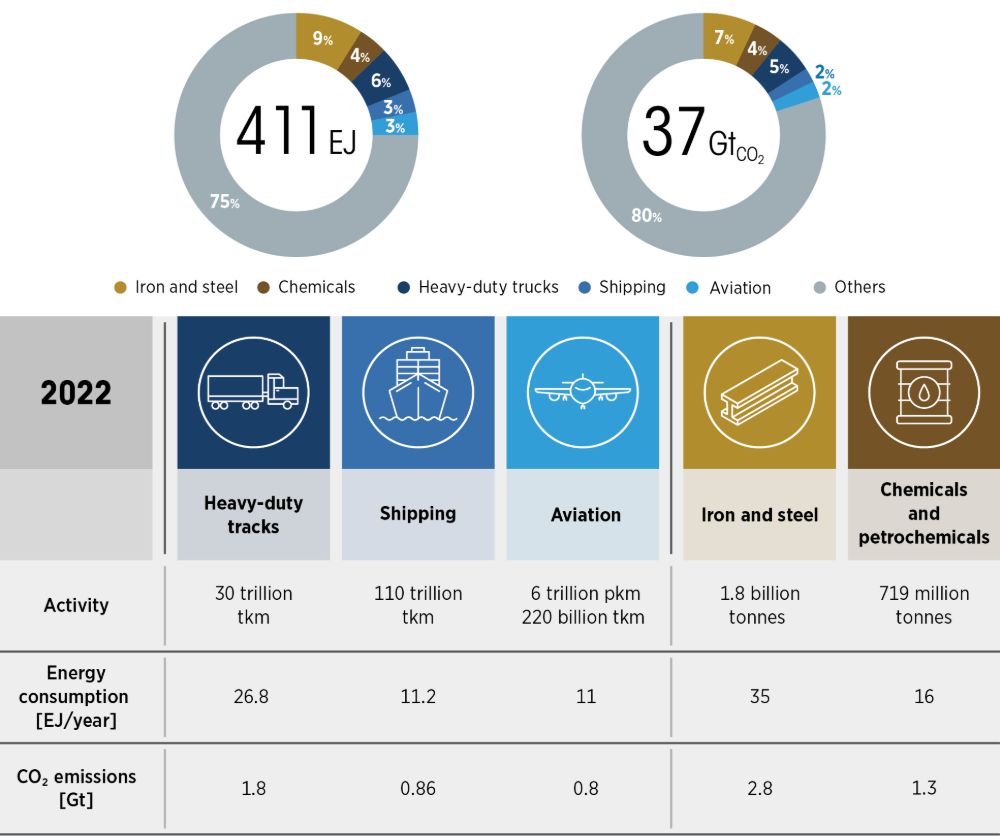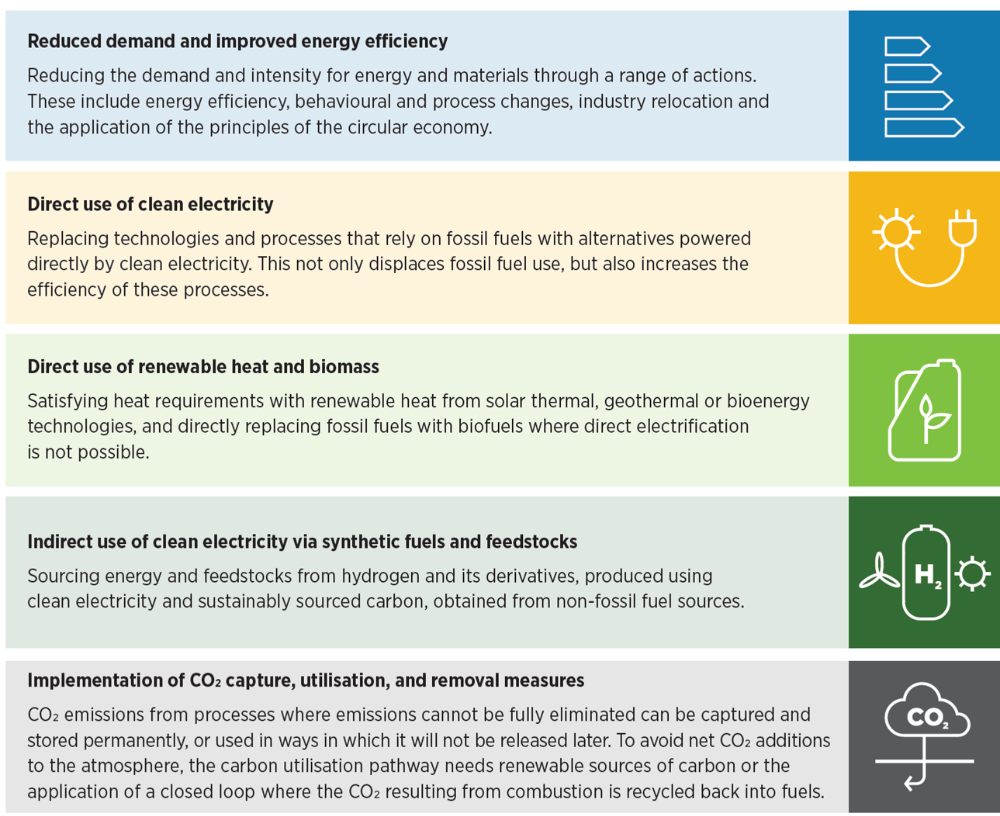Introduction
1.1 Objectives and structure of the toolkit
The International Renewable Energy Agency (IRENA) has called for an acceleration in the pace and scale of renewable energy deployment, highlighting the importance of renewable energy not only as an effective means of reducing emissions and enhancing energy security but also as a driver of economic growth and job creation. Countries and multilateral groupings, including the G7 and G20, have echoed the call for increasing renewable energy deployment (IRENA, 2023a, 2024a). The proliferation of renewable energy in the power sector has so far been the most prominent focus, but decarbonisation of hard-to-abate sectors using renewable energy also needs attention.
This toolkit focuses on decarbonising six hard-to-abate sectors and is structured in three sections. The first section introduces the decarbonisation challenge, the six hard-to-abate sectors, the five decarbonisation pathways for each sector, and an enabling framework that could help reduce emissions to net zero.
Section 2 delves deeper into the status, challenges and proposed technological pathways for short-term actions and longer-term efforts for the decarbonisation of each of the six hard-to-abate sectors. The toolkit also maps several enablers, within key enabling dimensions, that can be used to achieve decarbonisation in these sectors, presenting a non-exhaustive summary of the progress and challenges of each enabler for each sector. These enablers extend beyond traditional approaches to decarbonisation, which tend to operate through a siloed technology and policy lens, to incorporate elements such as markets, finance and supply chains.
Section 3 draws conclusions to provide a higher-level perspective on decarbonisation priorities, highlighting cross-cutting issues and commonalities in terms of challenges, enabling conditions and solutions for the different sectors. Section 3 also makes recommendations about how countries can support the successful decarbonisation of these sectors.
This toolkit is a practical guide for policy makers, industry leaders and other stakeholders to inform strategic planning and decision making in decarbonising hard-to-abate sectors. It aims to provide technology-focused pathways for both near-term and long-term actions, along with an overview of key enablers, to help identify priority areas for intervention. Additionally, it can serve as a benchmarking tool to assess global and regional efforts, identify gaps and opportunities, and offer synergies to align efforts across sectors and regions to drive co-ordinated action across the six sectors.
1.2 Decarbonising hard-to-abate sectors with renewables
For some sectors, such as electricity supply, the path to net-zero emissions is clear. Most technologies for this sector are mature and commercially available, and the transformation is accelerating. Renewable technology costs have also dropped drastically over the last couple of decades, resulting in unprecedented deployment rates. In 2024, 92% of electricity capacity additions globally were renewable – up from 53% in 2013 (IRENA, 2025).
Something similar is happening with passenger road transport, where battery electric vehicle (EV) adoption is rising exponentially. Some 17 million fully electric and plug-in hybrid passenger cars were sold in 2024 alone – more than 20% of total global automobile sales (IEA, 2025a).
While the energy transition will involve the decarbonisation of the power, transport, and heating and cooling sectors, there are elements of the energy system that are more complex and costlier to decarbonise. This is due to technological limitations, economic and geopolitical concerns, and these sectors’ extensive demand for energy. These sectors are referred to as “hard to abate”. This toolkit looks at six hard-to-abate sectors: heavy-duty trucks, shipping, aviation, iron and steel, chemicals and petrochemicals, and cement. It elaborates on the status of the transformation in these sectors and on the technological pathways and enablers needed to decarbonise them. These six sectors account for roughly a quarter of the world’s energy consumption and are responsible for around a fifth of total global carbon dioxide (CO2) emissions (Figure 1). This toolkit also provides actionable recommendations that stakeholders can follow to accelerate global efforts to decarbonise these sectors.
The steps that need to be taken to decarbonise these sectors have long been debated, and progress on the implementation of these steps has been very slow. However, the unprecedented social and political momentum now pushing for an acceleration in decarbonisation and the technological maturity and increasing competitiveness of renewable power and other enabling technologies have potentially brought the solutions closer to reality for some of these sectors. As a result, despite an increase in global energy-related CO2 emissions in 2023, for the first time the absolute emissions in the hard-to-abate sectors have reduced, by 0.9% from 2022 to 2023, signalling a positive step forward for decarbonisation. Yet, with these sectors currently contributing 27% of global CO2 emissions, efforts need to be ramped up in the coming decades to achieve global climate and sustainability targets.
In the context of geopolitical uncertainties and supply chain vulnerabilities, governments are aiming to balance decarbonisation goals with priorities for competitiveness, resilience and security. However, these objectives need not be at odds with decarbonisation goals for hard-to-abate sectors, as investing in clean technologies and enabling infrastructure has the potential to build new industries and reduce reliance on fossil fuel imports. Aligning decarbonisation goals with national interests is not only an important avenue to reaffirm a commitment to decarbonising the economy but also a strategic opportunity for economic and sustainable growth.
The initiatives undertaken by the European Union, as an example, aim to address the competitiveness, resilience and security of the region while doubling down on long-standing climate commitments. The European Commission, for instance, has released the Competitiveness Compass, which aims to boost the region’s economy by laying the groundwork for a clean industrial base (European Commission, 2025a). The objectives stated in the Competitiveness Compass address this goal by co-ordinating actions on clean, affordable energy, creating markets for clean products, making finance available, addressing the skills shortage, and other initiatives. Such a holistic perspective aligns short-term needs with long-term objectives and is essential for achieving resilient and sustainable industrial transformation.
Figure 1: Global energy consumption (top left), CO2 emissions (top right) and activity metrics (bottom) for select hard-to-abate sectors, 2023

Source: ICAO, 2023a; IEA, 2023a, 2023b; UNCTAD, 2022.
IRENA’s perspective on achieving net-zero CO2 emissions recognises that while each sector is different and will require different approaches, most emission reductions will have to be achieved through a combination of five main pathways, which rely primarily on renewable energy and energy efficiency (IRENA, 2020) (Figure 2).
Figure 2: Main technology pathways for the decarbonisation of hard-to-abate sectors

The window of opportunity for meaningful action to counter the global climate threat is closing fast. Options that deliver only partial emission reductions – such as replacing oil and coal with natural gas or adopting blue fuels, which rely on fossil feedstocks – are not sufficient. Decision makers should avoid delaying their decarbonisation objectives and prioritise solutions that are consistent with net-zero emissions. Most of these solutions rely on renewable energy.